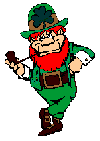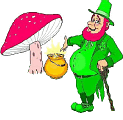An Irish Blessing
| St. Patrick's Day is celebrated on March 17 to honor Patrick, Ireland's patron saint. Almost 1500 years ago the patron saint and national hero of Ireland was born to a Gaelic family who had migrated to Britain. The child was called Succat, which means "war like". Since Britain was part of the Roman Empire and had become Christian, the child was baptized and called Patricius, meaning "noble." For 16 years, Patrick lived a normal life as the son of a prosperous landowner and magistrate. Captured and forced into slavery, Patrick spent 6 years herding sheep. What is known is that he escaped. What is also known, is that after a period of time, Patrick returned to Ireland to do missionary work. On his return to Ireland, Patrick was a missionary who worked for 40 years in Ireland, preaching, baptizing, and establishing churches, schools and colleges. |  |
 History reports that he used
shamrock leaves to explain the meaning of the Trinity. It
is also stated that he drove snakes from Ireland,
banishing the venomous serpents by beating his
drum. It is sometimes reported that Saint Patrick
died on March 17, 493 after bringing the Christian faith
to Ireland. This date is not confirmed. History reports that he used
shamrock leaves to explain the meaning of the Trinity. It
is also stated that he drove snakes from Ireland,
banishing the venomous serpents by beating his
drum. It is sometimes reported that Saint Patrick
died on March 17, 493 after bringing the Christian faith
to Ireland. This date is not confirmed. |
 |


 |
The first Irish celebrations on the date of Saint Patrick's death were noisy affairs. As the Irish emigrated around the world, they took the Saint Patrick celebrations with them, and today parades are held in some of the unlikeliest places you can imagine. |
| The Irish heritage has had a profound influence on our nation. Nine of the people who signed the Declaration of Independence were of Irish origin, and nineteen Presidents of the United States proudly claim Irish heritage including the first president , George Washington. |  |
My Canada
Pages
my recipe pages.
Visit
my holiday pages!
Valentines/Easter/Halloween/Mother/Father//Christmas/Family Tree/